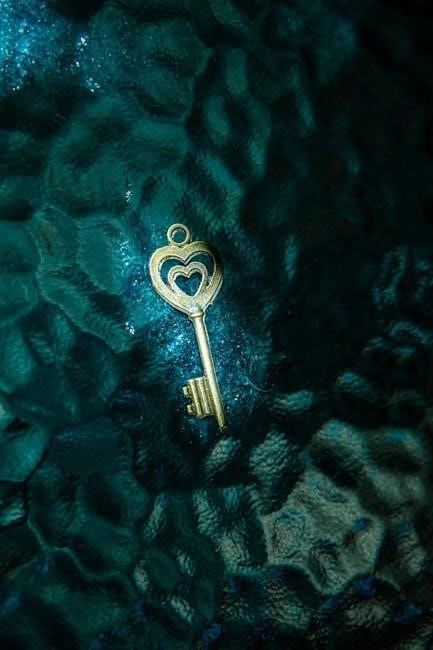frog dissection worksheet answer key pdf
Frog dissection is a hands-on learning experience in biology education, offering insights into vertebrate anatomy. This worksheet provides a structured guide for students to explore external and internal anatomy, compare frog and human systems, and understand key biological concepts through practical observation and analysis.

Importance of Frog Dissection in Biology Education
Frog dissection is a cornerstone of biology education, offering students a hands-on opportunity to explore vertebrate anatomy and biological systems. It enhances understanding of internal and external structures, fostering a deeper appreciation for comparative anatomy. The process encourages critical thinking and scientific inquiry, while structured worksheets guide students in identifying organs and systems. This practical experience bridges theoretical knowledge with real-world observation, preparing students for advanced studies in life sciences. The use of worksheets ensures comprehensive learning, making frog dissection an invaluable educational tool.

Structure and Content of the Worksheet
The worksheet is designed to guide students through frog dissection, covering external anatomy, internal organs, and comparative anatomy with humans. It includes labeled diagrams, identification of structures, and conclusion questions to reinforce learning. Answer keys are provided for assessment and verification.

External Anatomy
The external anatomy section of the worksheet focuses on identifying key features of the frog’s outer structure. Students are instructed to locate and label parts such as the dorsal and ventral sides, forelegs, hindlegs, eyes, nostrils, and mouth. The worksheet provides a diagram for accurate identification and includes questions about the functions of these external features. For instance, students are asked to explain the role of the frog’s webbed feet in movement and the purpose of its skin texture. This section also guides students to determine the sex of the frog by examining the forelegs, with males typically having thicker, more muscular forelimbs used for mating. Answer keys are included to ensure students can verify their understanding of these external characteristics, which form the foundation for exploring the frog’s internal anatomy in subsequent sections.
Internal Anatomy
The internal anatomy section of the worksheet delves into the frog’s organs and their functions. Students are guided to identify and label the heart, lungs, liver, stomach, small intestine, and other vital organs. The worksheet provides detailed instructions on how to carefully open the abdominal cavity to expose these structures. Questions in this section ask students to describe the roles of each organ, such as the heart’s function in circulating blood and the liver’s role in detoxification. The answer key includes explanations for each organ’s purpose, ensuring students grasp the interconnectedness of these systems. Additionally, the worksheet may include diagrams or illustrations to aid in accurate identification. This section is crucial for understanding how frogs maintain bodily functions and survive in their environments. By examining the internal anatomy, students gain insights into the biological processes that sustain life in amphibians, preparing them for comparative studies with human anatomy in later sections.

Preparation for Frog Dissection Lab
Preparation involves obtaining preserved frogs, setting up dissecting pans, and gathering tools. Students should review safety protocols and watch video demonstrations. Ensure all materials are ready for a smooth and safe dissection experience. Ethical considerations are emphasized to promote responsible handling of specimens.
Obtaining Specimens
Obtaining frog specimens is a critical step in preparing for dissection labs. Frogs are typically sourced from biological supply companies, such as Carolina, which provide preserved or injected specimens. Grass frogs or bullfrogs are commonly used due to their size and anatomical clarity. Teachers should ensure specimens are ethically sourced and handled with care to promote responsible scientific practice. Ordering in advance is recommended to guarantee availability. Specimens should be stored properly in a cool, dry place until use. Additionally, schools must comply with local regulations regarding the use of biological materials. Proper labeling and distribution of specimens to students are essential for a well-organized lab session. This step ensures that the dissection process is both educational and respectful of the specimens.
Necessary Tools and Equipment
Conducting a frog dissection requires specific tools and equipment to ensure a safe and effective learning experience. Essential tools include a scalpel or dissecting knife for making precise incisions, forceps for handling small organs, and dissecting scissors to cut through tissues and membranes. A dissecting pan or tray is necessary to hold the frog securely during the process. Additional tools like a magnifying glass or stereo microscope can aid in observing intricate structures. Students should also wear gloves and goggles to protect themselves from potential chemical exposure or accidental cuts. Proper lighting is crucial for visibility, and a hand lens can provide a closer view of internal organs. Teachers should ensure all equipment is sterilized and distributed safely to avoid contamination. Having a well-prepared setup with all necessary tools ensures that students can focus on learning anatomy without distractions. This preparation also helps maintain a structured and organized lab environment.

Comparative Anatomy: Frogs vs. Humans
Comparative anatomy between frogs and humans reveals fascinating insights into evolutionary biology. While frogs and humans belong to different classes (amphibians and mammals, respectively), their anatomical structures share some similarities due to shared vertebrate ancestry. For instance, both have a heart, liver, pancreas, and other vital organs, though their functions and structures differ significantly. The frog’s heart, for example, has three chambers, whereas the human heart has four, reflecting adaptations to terrestrial life. Students can compare the digestive systems, noting that frogs have a shorter digestive tract suited for a carnivorous diet, while humans have a longer system for omnivorous consumption. The respiratory systems also differ: frogs breathe through moist skin and lungs, while humans rely solely on lungs. This comparison enhances understanding of how anatomical adaptations reflect environmental and evolutionary pressures; Worksheets often include labeled diagrams for side-by-side comparison, helping students identify homologous structures and appreciate the diversity of life. Such comparisons are essential for grasping broader biological principles and the functional design of body systems. Educational resources, like PDF guides, facilitate this learning process.

Safety and Ethical Considerations in Dissection
Safety and ethical considerations are paramount during frog dissection labs. Students must wear gloves, goggles, and lab coats to protect themselves from preservatives like formaldehyde. Proper handling of dissection tools, such as scalpels and forceps, is essential to prevent accidents. Ethical practices include ensuring frogs are sourced from reputable biological supply companies and treated with respect, as they are vital for educational purposes. Many institutions emphasize alternatives to dissection, such as virtual simulations, for students who object to dissection. Supervision by trained instructors ensures adherence to safety protocols and ethical guidelines. Post-dissection, proper disposal of specimens and cleaning of equipment are mandatory to maintain a safe learning environment. These practices not only safeguard students but also promote a responsible approach to scientific inquiry. By addressing both safety and ethics, educators create a respectful and secure setting for hands-on learning experiences. These considerations are integral to fostering a culture of accountability and respect in biology education. Worksheet guides often include sections on safety and ethics to reinforce these principles.

Digital Resources and PDF Availability
Digital resources, including frog dissection worksheets and answer keys, are widely available as PDFs. These documents provide comprehensive guides for students and educators, covering external and internal anatomy, comparative studies, and post-lab questions. Many resources can be downloaded or accessed via Google Docs, ensuring easy distribution and use.
Frog Dissection Worksheet PDFs
Frog dissection worksheet PDFs are essential tools for biology students, providing structured exercises to enhance learning. These documents often include labeled diagrams, comparative anatomy charts, and post-lab questions. They guide students through identifying external and internal structures, such as the mouth, abdominal organs, and reproductive systems. Many PDFs also offer answer keys, enabling self-assessment and reinforcing key concepts. Available for download from educational websites and biological supply companies, these resources are adaptable for both classroom and virtual learning environments. Teachers can easily distribute them, ensuring students have comprehensive materials to support their dissection activities and deepen their understanding of vertebrate anatomy.
Online Simulations and Virtual Tools
Online simulations and virtual tools have revolutionized frog dissection education, offering interactive and immersive learning experiences. These resources provide detailed 3D models of frog anatomy, allowing students to explore external and internal structures virtually. Many simulations include step-by-step dissection guides, complete with clickable labels and descriptions of organs. Virtual tools also enable students to practice dissection techniques without the need for physical specimens, making them a cost-effective and environmentally friendly alternative. Platforms like PhET Interactive Simulations and Froguts offer comprehensive virtual labs, complete with quizzes and assessment features to reinforce learning. Additionally, virtual dissection tools often include comparative anatomy sections, where students can contrast frog anatomy with that of humans. These resources are particularly useful for remote learning environments or schools with limited access to lab materials. By leveraging technology, online simulations and virtual tools enhance engagement and provide a flexible way for students to grasp complex biological concepts.

Assessment and Evaluation in Frog Dissection Labs
Assessment in frog dissection labs involves evaluating student understanding through lab reports, worksheets, and practical exams. Worksheets with answer keys ensure accuracy in identifying anatomy, while lab performance tests dissecting skills and knowledge of biological processes.
Methods of Assessment
Assessment in frog dissection labs employs multiple methods to evaluate student learning. Worksheets with answer keys are used to test anatomy identification and understanding of biological concepts. Practical exams assess dissection skills, while lab reports evaluate critical thinking and knowledge retention. Group participation and peer reviews also contribute to comprehensive evaluation.
Assessment Tools and Techniques
Assessment in frog dissection labs utilizes a variety of tools and techniques to gauge student comprehension. Worksheets with detailed answer keys are fundamental, featuring exercises like labeling external and internal anatomy, ensuring accurate identification of organs and systems. Short-answer questions and comparative analyses between frog and human anatomy evaluate critical thinking and application of knowledge. Practical assessments may include dissection skills tests, where students demonstrate their ability to identify structures under supervision. Lab reports and diagrams further assess understanding, with emphasis on clarity and precision. Additionally, digital tools like virtual dissection simulations offer interactive quizzes, reinforcing learning through engaging platforms. Teachers may also incorporate peer reviews and group presentations to foster collaborative learning and comprehensive evaluation. These diverse methods ensure a holistic assessment of both theoretical knowledge and practical proficiency in frog dissection.

Common Challenges and Troubleshooting
Common challenges in frog dissection labs include difficulty in identifying anatomical structures, especially for novice students. Troubleshooting involves providing detailed worksheets with labeled diagrams and answer keys to guide identification. Preserved specimens may sometimes be poorly prepared, making dissection messy or structures hard to distinguish. Instructors should ensure specimens are stored properly and handled gently to maintain integrity. Safety concerns, such as accidental cuts or allergic reactions, can be mitigated by emphasizing proper tool usage and wearing gloves. Time management is another challenge, as dissections can be time-consuming. To address this, teachers can break the lab into structured sections or provide timed guidance. Additionally, some students may feel squeamish or uncomfortable with dissection, so offering alternative virtual simulations can be a solution. By anticipating these issues and having clear troubleshooting strategies, educators can ensure a smooth and effective learning experience for all students.
